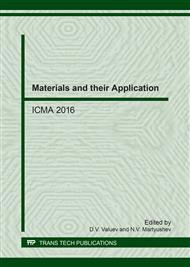p.23
p.29
p.35
p.40
p.46
p.52
p.58
p.63
p.68
Tungsten Surface Erosion by Hydrogen Plasma Irradiation
Abstract:
Changes in the structure and the tungsten surface erosion by hydrogen plasma irradiation are studied in the article. It is shown that the change in the surface topography as a result of the development of the non-homogeneous surface etching is observed after surface irradiation. Metallographic analysis showed that the degree of relief is low in comparison with tungsten sample irradiated at T=700°C by tungsten samples irradiation at T=1000°C and 1500°C. However, these samples have small cracks, while the temperature increases the size and number of cracks also increases. It is determined, that the surface roughness varies depending on the irradiation temperature after hydrogen plasma exposure. The greatest increase in the roughness occurs in samples irradiated at T=1500°C, which is associated with the formation of small cracks in the surface layer. It is shown that a degree of surface erosion is increased with increase of the target temperature and the ion energy. Appreciable tungsten erosion due to irradiation of the plasma flow, plasma simulating stationary mode occurs only at relatively high temperatures of the target.
Info:
Periodical:
Pages:
46-51
Citation:
Online since:
June 2017
Authors:
Keywords:
Price:
Сopyright:
© 2017 Trans Tech Publications Ltd. All Rights Reserved
Share:
Citation:


